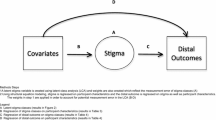Abstract
Although a growing body of literature has explored the association between religion and the prevalence of sexually transmissible infections (STIs), the focus has mainly been on HIV/AIDS and developing countries. Using data from the British National Surveys of Sexual Attitudes and Lifestyles (Natsal), we examine the direct association between religion and the prevalence of STIs including individual perception of exposure and risk of STIs. We focus on the importance of religion to respondents, religious affiliation as well as frequency of attendance to religious meetings. Our analyses suggest that being religious and frequently attending religious meetings are associated with lower odds of being diagnosed with STIs as well as lower self-assessed risk of getting HIV/AIDS. This seems particularly true for adherents of Christianity and more specifically, those of the Catholic denomination.
Similar content being viewed by others
Notes
Abbott et al. (2016) define sexual attitudes as the different ways in which individuals feel and think about sex and sexuality including premarital sex and homosexuality.
References
Abbott, D. M., Harris, J. E., & Mollen, D. (2016). The impact of religious commitment on women’s sexual self-esteem. Sexuality & Culture, 20(4), 1063–1082. https://doi.org/10.1007/s12119-016-9374-x.
Adamczyk, A., & Hayes, B. E. (2012). Religion and sexual behaviors: Understanding the influence of Islamic cultures and religious affiliation for explaining sex outside of marriage. American Sociological Review, 77(5), 723–746.
Agadjanian, V. (2005). Gender, religious involvement, and HIV/AIDS prevention in Mozambique. Social Science & Medicine, 61(7), 1529–1539. https://doi.org/10.1016/j.socscimed.2005.03.012.
Ahrold, T. K., Farmer, M., Trapnell, P. D., & Meston, C. M. (2011). The relationship among sexual attitudes, sexual fantasy, and religiosity. Archives of sexual behavior, 40(3), 619–630. https://doi.org/10.1007/s10508-010-9621-4.
Awaworyi Churchill, S., Farrell, L., & Smyth, R. (2019). Neighbourhood ethnic diversity and mental health in Australia. Health Economics, 28(9), 1075–1087. https://doi.org/10.1002/hec.3928.
Awaworyi Churchill, S., Ocloo, J. E., & Siawor-Robertson, D. (2017). Ethnic diversity and health outcomes. Social Indicators Research, 134(3), 1077–1112. https://doi.org/10.1007/s11205-016-1454-7.
Barkan, S. E. (2006). Religiosity and premarital sex in adulthood. Journal for the Scientific Study of Religion, 45(3), 407–417.
Beadnell, B., Morrison, D. M., Wilsdon, A., Wells, E. A., Murowchick, E., Hoppe, M., et al. (2005). Condom use, frequency of sex, and number of partners: Multidimensional characterization of adolescent sexual risk-taking. The Journal of Sex Research, 42(3), 192–202. https://doi.org/10.1080/00224490509552274.
Call, V. R., & Heaton, T. B. (1997). Religious influence on marital stability. Journal for the Scientific Study of Religion, 36, 382–392.
Christiano, K. J., Swatos, W. H., & Kivisto, P. (2015). Sociology of religion: Contemporary developments. Lanham: Rowman & Littlefield.
Cochran, J. K., Chamlin, M. B., Beeghley, L., & Fenwick, M. (2004). Religion, religiosity, and nonmarital sexual conduct: An application of reference group theory. Sociological Inquiry, 74(1), 70–101.
Davidson, J. K., Moore, N. B., & Ullstrup, K. M. (2004). Religiosity and sexual responsibility: Relationships of choice. American Journal of Health Behavior, 28(4), 335–346.
Doolittle, B. R., Justice, A. C., & Fiellin, D. A. (2018). Religion, spirituality, and HIV clinical outcomes: a systematic review of the literature. AIDS and Behavior, 22(6), 1792–1801. https://doi.org/10.1007/s10461-016-1651-z.
Erens, B., Phelps, A., Clifton, S., Mercer, C. H., Tanton, C., Hussey, D., et al. (2013). Methodology of the third British National Survey of sexual attitudes and lifestyles (Natsal-3). Sexually Transmitted Infections. https://doi.org/10.1136/sextrans-2013-051359.
Ford, K., & Lepkowski, J. M. (2004). Characteristics of sexual partners and STD infection among American adolescents. International Journal of STD & AIDS, 15(4), 260–265.
Kawsar, M., Anfield, A., Walters, E., McCabe, S., & Forster, G. (2004). Prevalence of sexually transmitted infections and mental health needs of female child and adolescent survivors of rape and sexual assault attending a specialist clinic. Sexually Transmitted Infections, 80(2), 138–141.
Kimberly, C., Werner-Wilson, R., & Motes, Z. (2014). Brief report: Expanding the brief sexual attitudes scale. Sexuality Research and Social Policy, 11(1), 88–93.
Lefkowitz, E. S., Gillen, M. M., Shearer, C. L., & Boone, T. L. (2004). Religiosity, sexual behaviors, and sexual attitudes during emerging adulthood. The Journal of Sex Research, 41(2), 150–159. https://doi.org/10.1080/00224490409552223.
Luquis, R. R., Brelsford, G. M., & Rojas-Guyler, L. (2012). Religiosity, spirituality, sexual attitudes, and sexual behaviors among college students. Journal of Religion and Health, 51(3), 601–614.
Macdowall, W., Jones, K. G., Tanton, C., Clifton, S., Copas, A. J., Mercer, C. H., et al. (2015). Associations between source of information about sex and sexual health outcomes in Britain: Findings from the third National Survey of Sexual Attitudes and Lifestyles (Natsal-3). British Medical Journal Open. https://doi.org/10.1136/bmjopen-2015-007837.
Manzou, R., Schumacher, C., & Gregson, S. (2014). Temporal dynamics of religion as a determinant of HIV infection in East Zimbabwe: A serial cross-sectional analysis. PLoS ONE, 9(1), e86060.
Maybruch, C., Pirutinsky, S., & Pelcovitz, D. (2014). Religious premarital education and marital quality within the Orthodox Jewish community. Journal of Couple & Relationship Therapy, 13(4), 365–381.
McFarland, M. J., Uecker, J. E., & Regnerus, M. D. (2011). The role of religion in shaping sexual frequency and satisfaction: Evidence from married and unmarried older adults. Journal of Sex Research, 48(2–3), 297–308.
Mercer, C. H., Tanton, C., Prah, P., Erens, B., Sonnenberg, P., Clifton, S., et al. (2013). Changes in sexual attitudes and lifestyles in Britain through the life course and over time: Findings from the National Surveys of Sexual Attitudes and Lifestyles (Natsal). The Lancet, 382(9907), 1781–1794. https://doi.org/10.1016/S0140-6736(13)62035-8.
Mohammed, H., Blomquist, P., Ogaz, D., Duffell, S., Furegato, M., Checchi, M., et al. (2018). 100 years of STIs in the UK: A review of national surveillance data. Sexually Transmitted Infections, 94(8), 553–558.
Murray, K. M., Ciarrocchi, J. W., & Murray-Swank, N. A. (2007). Spirituality, religiosity, shame and guilt as predictors of sexual attitudes and experiences. Journal of Psychology and Theology, 35(3), 222–234.
Njus, D. M., & Bane, C. M. (2009). Religious identification as a moderator of evolved sexual strategies of men and women. Journal of Sex Research, 46(6), 546–557.
Obermeyer, C. M. (1992). Islam, women, and politics: The demography of Arab countries. Population and Development Review, 18(1), 33–60. https://doi.org/10.2307/1971858.
Regnerus, M. D. (2005). Talking about sex: Religion and patterns of parent–child communication about sex and contraception. The Sociological Quarterly, 46(1), 79–105.
Shaw, S. A., & El-Bassel, N. (2014). The influence of religion on sexual HIV risk. AIDS and Behavior, 18(8), 1569–1594.
Sheeran, P., Abrams, D., Abraham, C., & Spears, R. (1993). Religiosity and adolescents’ premarital sexual attitudes and behaviour: An empirical study of conceptual issues. European Journal of Social Psychology, 23(1), 39–52. https://doi.org/10.1002/ejsp.2420230104.
Sovran, S. (2013). Understanding culture and HIV/AIDS in sub-Saharan Africa. SAHARA: Journal of Social Aspects of HIV/AIDS Research Alliance, 10(1), 32–41.
Svare, E. I., Kjaer, S. K., Worm, A. M., Østerlind, A., Meijer, C. J. L. M., & van den Brule, A. J. C. (2002). Risk factors for genital HPV DNA in men resemble those found in women: A study of male attendees at a Danish STD clinic. Sexually Transmitted Infections, 78(3), 215–218. https://doi.org/10.1136/sti.78.3.215.
Takyi, B. K. (2003). Religion and women’s health in Ghana: Insights into HIV/AIDS preventive and protective behavior. Social Science & Medicine, 56(6), 1221–1234.
Tanton, C., Jones, K. G., Macdowall, W., Clifton, S., Mitchell, K. R., Datta, J., et al. (2015). Patterns and trends in sources of information about sex among young people in Britain: evidence from three National Surveys of Sexual Attitudes and Lifestyles. British Medical Journal Open. https://doi.org/10.1136/bmjopen-2015-007834.
Trinitapoli, J. (2009). Religious teachings and influences on the ABCs of HIV prevention in Malawi. Social Science & Medicine, 69(2), 199–209.
Trinitapoli, J., & Regnerus, M. D. (2006). Religion and HIV risk behaviors among married men: Initial results from a study in rural Sub-Saharan Africa. Journal for the Scientific Study of Religion, 45(4), 505–528.
Uecker, J. E. (2008). Religion, pledging, and the premarital sexual behavior of married young adults. Journal of Marriage and Family, 70(3), 728–744.
Wilcox, W. B., Chaves, M., & Franz, D. (2004). Focused on the family? Religious traditions, family discourse, and pastoral practice. Journal for the Scientific Study of Religion, 43(4), 491–504.
Wilcox, W. B., & Nock, S. L. (2006). What’s love got to do with it? Equality, equity, commitment and women’s marital quality. Social Forces, 84(3), 1321–1345.
Zou, J., Yamanaka, Y., John, M., Watt, M., Ostermann, J., & Thielman, N. (2009). Religion and HIV in Tanzania: Influence of religious beliefs on HIV stigma, disclosure, and treatment attitudes. BMC Public Health, 9(75), 1–12. https://doi.org/10.1186/1471-2458-9-75.
Funding
No funding sources declared.
Author information
Authors and Affiliations
Corresponding author
Ethics declarations
Conflict of interest
The authors declare that they have no conflict of interest.
Ethical Approval
This article does not contain any studies with human participants or animals performed by any of the authors.
Additional information
Publisher's Note
Springer Nature remains neutral with regard to jurisdictional claims in published maps and institutional affiliations.
Appendix
Rights and permissions
About this article
Cite this article
Awaworyi Churchill, S., Appau, S. & Ocloo, J.E. Religion and the Risks of Sexually Transmissible Infections: Evidence from Britain. J Relig Health 60, 1613–1629 (2021). https://doi.org/10.1007/s10943-021-01239-0
Accepted:
Published:
Issue Date:
DOI: https://doi.org/10.1007/s10943-021-01239-0




